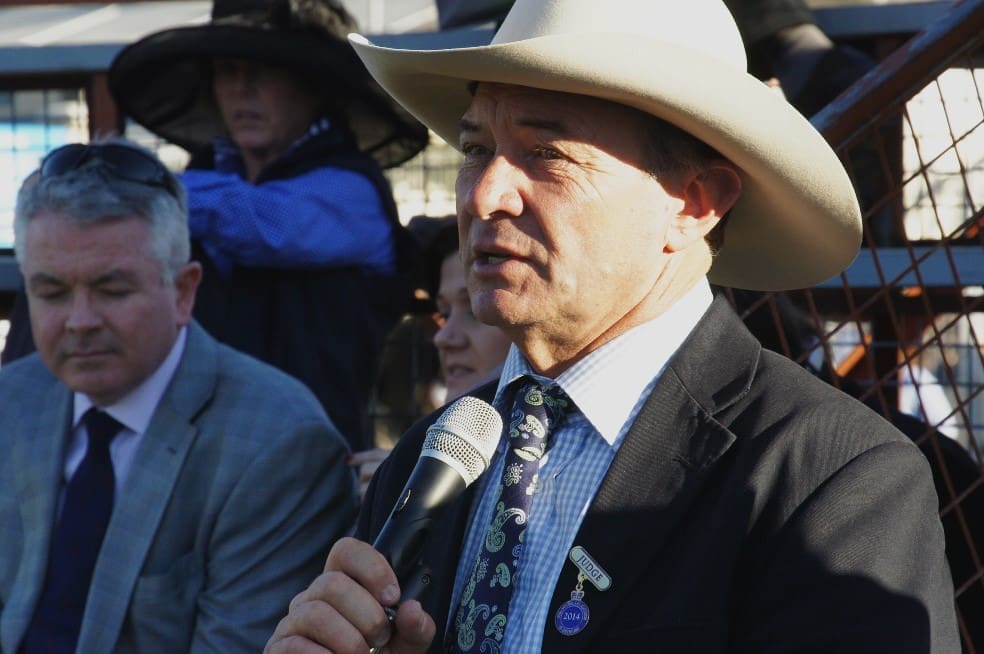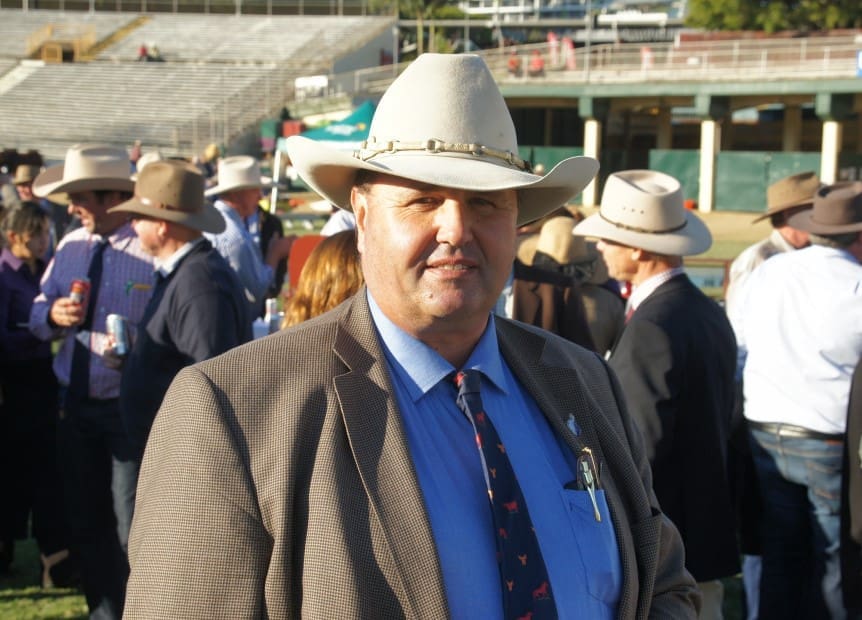Brisbane’s annual Royal Show kicked off yesterday and continues today with stud beef judging, representing what is arguably the largest annual gathering of stud beef cattle producers in Australia.
As such, it represents an excellent opportunity for Beef Central to gauge sentiment among stud breeders about prospects for the 2014 spring bull selling season.
Without exception, a broad cross section of stud and commercial herd bull producers spoken to yesterday have only modest expectations for sale results this year.
That sentiment appears to be driven by three key factors:
- The considerable decline in breeding capacity across Eastern Australia in the past two years as waves of females have been sent to slaughter because of the drought
- The poor financial returns to commercial beef producers this year caused by gross over-supply of slaughter cattle
- A general lack of confidence in prospects for the spring/summer season ahead.
While it’s important not to be seen to be ‘talking the market down,’ many bull breeders spoken to on the showgrounds in Brisbane yesterday displayed a pragmatic approach to how best to handle the likely supply/demand challenges this year.
The underlying message was that clearance rate was the priority this year, rather than average price.
What was clearly evident, though, is an exceptional opportunity for commercial bull buyers to access replacement bulls at what are likely to be very attractive prices.
And arguably, average quality of bulls on offer this year will be higher than ever. That’s because there’s clear evidence of stud breeders wielding the castrating knife earlier and more vigorously, or consigning more of the ‘tail’ of this year’s bull crop to the meatworks. That, inevitably, will push the average quality of bulls on offer this year further along the bell-curve.
Published here are a couple of representative responses from prominent stud breeders from Queensland and NSW about how they see this year’s spring selling season shaping up, and what they plan to do about it.
David Bondfield, Palgrove Charolais, Dalveen:
While Palgrove will hold its annual on-property sale as normal later this month, the nation’s best known Charolais seedstock operation has put a number of contingencies in place to account for this year’s market circumstances.
“It’s been a really tough year not only for ourselves, but so many of our clients as well, and we’ve needed to respond to that,” stud principal David Bondfield said.
“The good to come out of it will be the fact that, as seedstock producers, the inherent do-ability and constitution of cattle is so important in this country, so for us to go and ‘dig deeper’ into our herd, both males and females, and select those cattle that have come out the other end in better condition is paramount,” he said.
“Going forward, that’s a real positive.”
So far as Palgrove’s sale this year is concerned, Mr Bondfield admitted it was “not the greatest set of circumstances to be trying to sell bulls in.”
“Our own decision has been to significantly reduce the number of bulls we’re selling at auction. We’ll probably cut 20 percent off our normal auction numbers of around 150 bulls, to better match the likely demand,” he said.
Palgrove is also looking to assist regular clients, where it can, with some terms on delayed payments, to assist producers who have had financial difficulty this year due to drought and prices.
That 20pc of bulls not being offered in this year’s sale will be offered as herd bulls, but also, the Bondfields have been ‘harder on the bottom line’ this year, via the meatworks option.
“Realistically, the national cow herd is not anything like what it was 18 months ago, and bull breeders need to respond to that, accordingly,” he said.
“The flow-on to our end of the industry is very direct, and immediate.”
“On top of that, the rebuild will take a big season or two, and even then it will be a number of years, so overall bull demand will be soft for several cycles, at least.”
So how does the seedstock industry approach such challenges? Is there a breed-wide, and indeed seedstock sector-wide responsibility to educate breed society members about realistic prospects in a year like this? While some breeders will inevitably take the ‘responsible’ approach by reducing numbers and trying to manage the pool of bulls available to suit market demand, what guarantees are there that all breeders will do the same?
“It shouldn’t be circumstances like this year that make us do that,” Mr Bondfield said.
“We, as seedstock producers, should be doing it automatically, but a year like this drives people to do it. Yes, it is the individual breeders’ responsibility, but it would be great if there was a broader approach taken, through breed societies or whatever.”
To his knowledge, educating members at breed level, or across breeds (ARCBA, for example) had not included dialogue about the need to moderate bull numbers offered this year, as a responsible measure.
“It’s not as transparent as it should be. It would be a wonderful thing, but currently, it’s pretty much left up to the individual,” Mr Bondfield said.
“To stay in the industry, it’s about quality, customer service and matching supply and demand. I’d like to think that a lot of bull breeders, across all breeds, would be looking to reduce their sale offerings this spring by 20 percent,” he said.
Managing bull production cost
Palgrove is also looking to moderate the financial impact this year on the cost input side.
For the first time in decades, the business does not have a team competing in stud beef competition in Brisbane for example, although that decision is not specifically linked to the drought or expectations over this year’s bull prices.
With no green feed available, bull preparation this year has changed substantially, using a bought-in silage based ration.
“We were trying to do it as cost-effectively as we could, but there was a big freight component with barley straw and other commodities. But our clients don’t want to hear excuses – they still want to buy a well-presented product. You still have to tick that box.”
In Palgrove’s case, that will cost at least half as much again, if not double the normal bull preparation cost. It works on a typical bull preparation cost of $250-$300/head, but that could go to $450 this year.
Despite the disappointing prospects in 2014, Mr Bondfield remains optimistic for the future.
“The future prospects for Australian beef remain so robust, once we come out of this,” he said.
He agreed that the female liquidation that had occurred this year meant that the commercial cattle industry probably had the youngest age profile in its breeder ranks that it had had in the past 20 years, at least.
“The ones that have stayed in the herds should be genetically superior, the high-performers, and the most fertile – so there is a good base to work from,” he said.
Rob Sinnamon, Yulgilbar Santa Gertrudis, NSW
“It’s obvious to everybody that the 2014 bull season – at least in Queensland and the northern half of NSW – is going to be tough,” Rob Sinnamon told Beef Central at the Ekka yesterday.
“We’ve recognised that, and it’s going to be a year where all stud breeders (at least those servicing Queensland and central/northern parts of NSW where the worst of the drought impact has been seen) have to be realistic about expectations about sale price and bull turnover.”
Yulgilbar this year has taken fairly extreme measures to reduce its sale catalogue numbers by another 50 bulls, hoping to better align with demand.
“That’s down about 25pc on what we would normally sell. We opted to take that position quite early on, to clear those bulls out of the system, rather than over-subscribe the market,” Mr Sinnamon said.
Sending those ‘entry level’ bulls to the meatworks would inevitably mean that the overall standard of Yulgilbar sale bulls this year would be higher than ever.
“It means better quality, on average, from one of the catalogue to the other, and I think a lot of sales this year will be able to make that claim,” he said.
“Hopefully it will create enough competition for the balance of our bulls on offer this year. I see it as an opportunity for our clients to re-invest, at lower prices, in bulls that will be of exceptional average quality,” he said.
The trade-in value on cull herd bulls, at anywhere from $800 to $1200 depending on weight, made 2014 an outstanding opportunity to trade up into better, younger herd bulls.
“The industry can exploit the genetic gain by doing this – because the cow herd is younger than ever because of the recent high rates of female kill, meaning that genetic composition wise, the young female herd should be in great shape.”
Yulgilbar sometimes feeds a ration containing up to 25 percent grain, but has scaled that back to 10pc this year, due to costs, and price expectations.
“We’ve thinned things down a little where we can,” Mr Sinnamon said, “but we still want the bulls to be ready to go out and work.”
“Everybody says they want to buy them ready, but the market says they want to see them express some potential, as well, so there is no escaping some feeding.”
Certain production costs could not be compromised, however, with every bull in the catalogue tested free of pestivirus and carrying a poll status DNA test.
“Survival in tough times like this is about buyer service and back-up. We cannot afford to compromise on the basics, and to me, testing for pestivirus, a good vaccination schedule, soundness evaluation and semen testing is now a ‘given’ in a responsible stud program.”
“It’s as much to protect ourselves as our clients. Because we back our product 100pc, there is no point in us selling a product that isn’t going to perform.”
In other areas of cost-control this year, Yulgilbar has reduced some of its pre-sale print advertising costs, in favour of greater use of social and online media platforms.
“We’re focussing on our gross margins in everything we’re doing, and the ‘what if’ scenarios for the rest of the year, following the sale season.”
“If it doesn’t rain, there will be further reductions in costs, changing some of our strategies in marketing commercial cattle, perhaps bringing forward some of our long-term strategies.”
On the question of broader industry-wide approaches to managing yearly bull numbers, Mr Sinnamon said breed societies could make recommendations, but ultimately it came down to a responsible approach by individual breeders over the number of bulls they presented.
“At the end of the day it’s a commercial decision,” he said, “but it’s a difficult challenge, in what is a competitive marketplace, both within and between breeds.”
“It’s a matter of listening to people’s requirements, and capitalising where we see opportunities.”
“Just staying in business for next year is the start. This year will be more about achieving a satisfactory sale clearance rate, rather than focussing on each sale’s average price. It’s no good having an $8000 average price this year and only clearing 40pc of the bulls – the gross figure is the most important.”
Mr Sinnamon said the bull breeders on the New England who had had bull sales this season already, who had historically had good strong clientele and back up their cattle well, had sold OK.
“They haven’t made record prices, but their clearances have been reasonable. Some have actually lifted clearances a little on last year, because they’ve gone out and been a little more pro-active.”
“But collectively, as stud breeders, we need to be careful that we don’t become our own worst enemy, and undercut left-over auction bulls just to get rid of them. Buyers will soon grasp on that.”





HAVE YOUR SAY